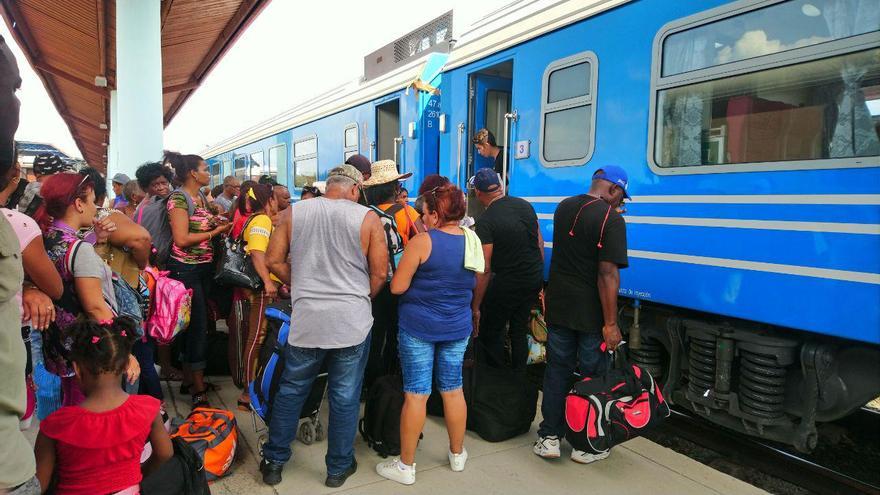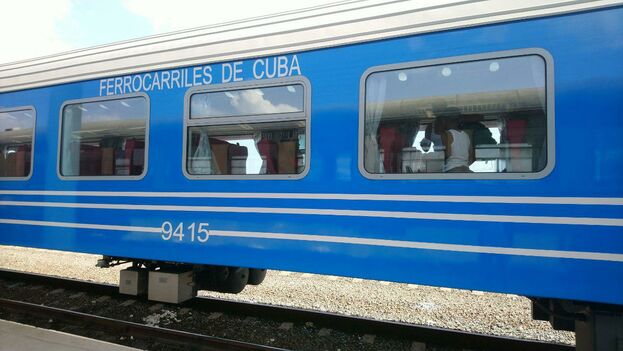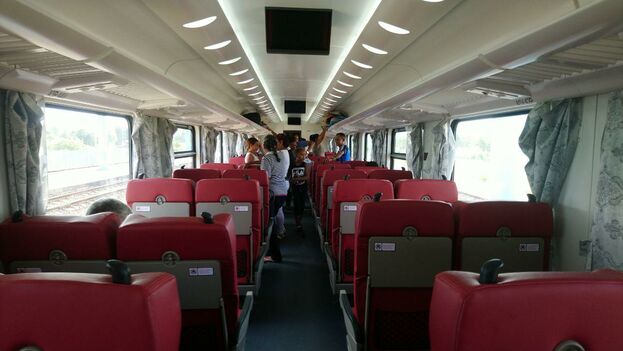
![]() 14ymedio, Luz Escobar, August 15, 2019 — Alfredo and his family welcomed the news that the train from Havana to Santiago would be adding new passenger cars purchased from China. After not visiting their family in eastern Cuba for years, they would now be able to make the journey quickly, economically and safely. They bought tickets and their children were excited to finally experience the inside of “a real train.”
14ymedio, Luz Escobar, August 15, 2019 — Alfredo and his family welcomed the news that the train from Havana to Santiago would be adding new passenger cars purchased from China. After not visiting their family in eastern Cuba for years, they would now be able to make the journey quickly, economically and safely. They bought tickets and their children were excited to finally experience the inside of “a real train.”
One morning in August, after a delay of almost three hours, they heard an announcement from La Coubre terminal’s loudspeakers to board “the long iron snake” that was arriving huffing and puffing a few yards from the waiting area. “When I got to the platform, I noticed that there was a policeman and a train attendant in every car,” Alfredo tells 14ymedio.
Once all the passengers had taken their seats, they were “read the riot act.” The attendant explained that the minimum fine for improper behavior was 200 pesos and that getting off at stations before the final destination was forbidden. The policeman added that passengers could only go from their seats to the bathroom and back, and were not allowed to walk between cars.

“Officials get off at every stop to make sure that no one leaves the train, not even the smokers,” recounted one surprised passenger. By the time the train departed Havana, children were still excited by the new seats and the train whistle but some passengers were already feeling uncomfortable.
“The trip itself takes fourteen hours to Santiago but it was delayed,” complains Alfredo. His own journey lasted almost eighteen hours, during which time his family went from euphoria to discomfort, desperately wanting to get out of the car and stretch their legs.
In another car, whose seats are cheaper because there is no air conditioning, sat Maricela, a woman who had been employed by the railroad company for twenty years but had never boarded a train in all that time. “The trains now are not like they were when I was young and was a transportation engineer for the Western Railroad Company,” she recalls.
“Back then the cars were nice, very comfortable, but that didn’t come as a surprise to anyone,” notes the 67-year-old retiree. “Now everyone wants to take photos as though this were the Eiffel Tower. I don’t know what all the happiness is about. It’s just an ordinary train, with not a lot of comforts,” she adds skeptically.
One of the few novelties the new vehicles have is a cell phone app that tells passengers and family members the train’s location in real time and its estimated time of arrival. But the app does not allow travellers to reserve or purchase tickets. “In the old days you didn’t need that. Trains arrived at every station right on time,” says Maricela.
The new train does not have a separate baggage car. Passengers must store their luggage and other packages in the space above their seats. After numerous complaints, rail employees informed passengers that the company is considering imposing restrictions next month on the size of suitcases, which would be limited to roughly 62 inches.
The size seems small to passengers accustomed to traveling with bulky luggage — typically filled with food, gifts and accessories — which they carry on their backs when they go on vacation.
When the new trains first went into service, passengers were not allowed to bring food from home onboard but now they can, though employees ask that they take special care to keep things clean. “In the car where I was, there was a cold water fountain which the attendant said had more than enough of water for the entire trip,” says Alfredo.
Although TV news reports had indicated that the new trains would have a dining car, it is not operational at this time. “They don’t think it even works,” adds Alfredo, who wonders how passengers are going to eat if they are not allowed to walk between cars.
A seat in a car that is not climate controlled costs 70 Cuban pesos while one that is air conditioned costs 95. For 20 pesos more you can get a snack consisting of a medium-sized ham and cheese sandwich with a canned soft drink that the attendant hands out during the trip.

Each car seats seventy passengers and there is adequate space between seats for them to stretch their legs. But as the rail attendant points out, “The cars are very long and they put a strain on the locomotives, which aren’t new.” This combined with train tracks that are in poor condition contribute to frequent delays.
At Santa Clara the train had to change engines. Employees explained this was due to the extra weight of the cars, which the engine could not handle. This technical maneuver further delayed a trip whose departure had already been pushed back by an hour.
Before getting off at the final destination, passengers had to present their tickets with their names, surnames and identity card numbers as well as their seat numbers. “It’s so that, if something is lost or broken on the train, they have someone to look for or investigate,” Alfredo speculates.
The train finally pulled into the Santiago de Cuba station. After it had stopped, the car doors opened and a surge of humanity spilled out at full speed. Relieved and tired, passengers were eager to get away from the railcars and locomotive as quickly as possible.
________________________
The 14ymedio team is committed to serious journalism that reflects the reality of deep Cuba. Thank you for joining us on this long road. We invite you to continue supporting us, but this time by becoming a member of 14ymedio. Together we can continue to transform journalism in Cuba.
